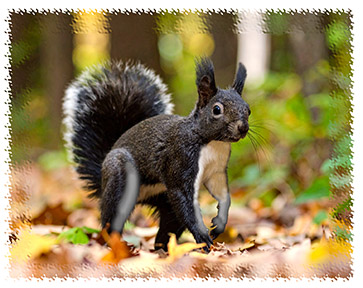Kaibab Squirrel Facts and Gifts
Get facts, information and plush toy Kaibab Squirrels at Animals N More.
The little Kaibab Squirrel stuffed animal shown above was made by Folkmanis. This unusual plush toy has been discontinued by Folkmanis and no one else is making a Kaibab or Abert's squirrel plush toy.
The Tufted-eared or Tassel-eared Squirrel, Sciurus aberti, is a big, handsome, heavy-bodied fellow noted for the elegant tall black tufts of hair that rise from its long ears. It lives in the great belt of yellow pine trees, which include the Ponderosa, that stretches in a narrow strip along the Rocky Mountains from the southern United States to Mexico.
Naturalists distinguish at least three different but closely related forms of the tufted-ear - the Abert, Kaibab, and Durango squirrels. Among the most elegant of the tree squirrels, they vary in color in certain regions. Still, their basic pattern is much the same: a soft lead-gray color, broken by a reddish-brown saddle, spreads over the back, while a coal-black line on the side sets off the snow-white under parts. The tail is large and bushy.
The tufted-eared squirrel usually builds a bulky nest of twigs and pine needles in the top if a great tree. It makes the nest about the size of a bushel basket and lines it with soft, shredded bark. From the outside it is a rough-looking, dome-shaped structure. But it is securely woven into the tree's branches, and it is strong enough to resist high winds and winter storms. In it the tufted-ear remains day after day when the weather is not to its liking, venturing out only for food.
The tufted-eared squirrel does not store up a supply of nuts and seeds for winter food, but depends largely on the bark of the yellow pines (including the Ponderosa) in which it lives. (In summer, though, it feeds on much the same fare that other tree squirrels do.)
When the snow starts to melt in the Rockies, this handsome squirrel begins to lose the heavy winter coat it grew in the fall, but the stately plumes on its ears, one and one-half inches long, are retained until early in June. These grow back again, however, in time for the next winter.
Families of three or four baby tufted-eared squirrels arrive early in June. (It is possible there is a second litter which is born around September.) They are weaned on the inner back of the tall straight pine trees and are taught to hunt mushrooms, bird nests, seeds and edible roots. Soon they are scampering about in the trees and chattering furiously with their elders. Under the protection of the United States Forest Service, the tribe leads a life of security in the Grand Canyon National Park, but in the wild forests of the American Southwest and northern Mexico it is cautious and wary of hunters.
Full grown, the tufted-eared squirrel is about twenty inches long and weighs up to two pounds.
Kingdom: Animalia, Phylum: Chordata, Class: Mammalia, Order: Rodentia,
Family: Sciuridae, Genus: Sciurus, Species: S. aberti






